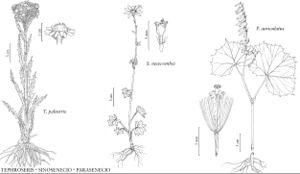Parasenecio
Trans. & Proc. Bot. Soc. Edinburgh 28: 93, plate 3. 1922.
| Taxon | Illustrator ⠉ | |
|---|---|---|
 | Tephroseris palustris Sinosenecio newcombei Parasenecio auriculatus | Yevonn Wilson-Ramsey Yevonn Wilson-Ramsey Yevonn Wilson-Ramsey |
Perennials, [20–] 60–120 [–200] cm (rhizomes fibrous-rooted; plants caulescent [subscapiform], glabrous or hairy). Stems usually 1, erect. Leaves basal and cauline; alternate; petiolate (petiole bases ± auriculate and clasping to sheathing; proximal and middle leaves largest); blades palmately nerved [and lobed], reniform to ± deltate [orbiculate, sometimes peltate], margins usually raggedly dentate, abaxial faces glabrous or puberulent (on veins) [puberulent to sericeous], adaxial glabrous. Heads discoid (nodding), in racemiform or subpaniculiform arrays. Calyculi 0 [present]. Involucres cylindric to weakly turbinate, 2–3+ mm diam. Phyllaries persistent, [3–] 5+ in 1–2 series, erect, distinct, oblong to linear, equal, margins ± scarious. Receptacles flat, smooth or foveolate, epaleate. Ray-florets 0. Disc-florets [1–] 4–7 [–20], bisexual, fertile; corollas white or ochroleucous [yellowish], tubes longer than funnelform throats, lobes 5, recurved or coiled, lance-linear to deltate; style-branches: stigmatic areas continuous, apices rounded-truncate. Cypselae ± ellipsoid, sometimes finely 10-ribbed, glabrous; pappi readily falling or fragile, of 100–120+, white [reddish], barbellulate bristles. x = 30.
Distribution
Alaska, mostly in ne Asia, especially China, Japan, and the Russian Far East
Discussion
Species ca. 60 (1 in the flora).
Species of this group were long treated in Cacalia; difficulties with the typification of that name led to its rejection (T. M. Barkley 1999). The genus Koyamacalia was erected by H. Robinson and R. D. Brettell (1973) for the Asiatic “core” of Cacalia, including the single species in the flora area; the name Parasenecio has priority.
Selected References
None.